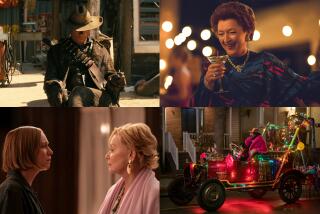Oscars: Watch the key scenes that helped these stars land nominations
Whether it’s gaining (or losing) weight, taking vocal and guitar lessons, or going deep into a quirky historical personality, actors put hundreds, if not thousands, of hours into their roles. And now that 10 of them are up for lead actor/actress Academy Awards, it’s worth going back to find the jewel in their crowns: that singular instance when all that planning, practice and talent came together — in a critical, key scene.
Glenn Close, “The Wife”
FULL COVERAGE: Get the latest on awards season from The Envelope »
Key Scene: After her husband is awarded the Nobel Prize for a literary work she has secretly written, Joan (Close) can’t keep up the charade any longer, and she demands a divorce.
What Makes It Great: “That scene is five or six minutes long, and it’s one of the most emotional scenes I’ve ever been involved with,” says director Björn Runge. “It collects all the emotions in the film: It’s about death and love and creativity and how we treat each other as man and wife. Glenn walked on that extremely sharp knife edge and on the right side all the time.”
Olivia Colman, “The Favourite”

Emma Stone and Olivia Coleman in a key scene from “The Favourite.”
Key Scene: As she’s being wheeled down a corridor, Queen Anne (Colman) overhears children playing music in the courtyard and yells at them to quit it.
What Makes It Great: Says director Yorgos Lanthimos, “The queen is having a very frail, sensitive moment — her mood is really mercurial, so when she hears this music it reminds her of the many children she’s lost, and it makes her lose it. Olivia can turn it up in a second — she looks frail in the wheelchair, and when she starts screaming, it’s like this energy has built up. It looks normal, in a way.”
Lady Gaga, “A Star Is Born”
Key Scene: Having not seen Jackson (Bradley Cooper) since the Grammy Awards debacle, Ally (Gaga) hopes to have a tender reunion at his rehab facility.
What Makes It Great: “She starts the scene with light and love, but also walking on eggshells because she doesn’t want to upset him,” says producer Lynette Howell Taylor. “She’s vulnerable and playing all these levels. After they inadvertently clash, “she registers hurt and shock, yet holds it in and ultimately is able to turn the scene into these two people connecting. She’s playing so beautifully and subtly and is so present in the scene – the scene shows her range as an actress.”
Melissa McCarthy, “Can You Ever Forgive Me?”
Key Scene: Convicted of forging letters from literary luminaries, Lee (McCarthy) is about to be sentenced. But she seems anything but remorseful as she addresses the judge, largely seeing the experience as a betrayal of herself as a writer.
What Makes It Great: “What Melissa delivers is one of the most vulnerable, bare performances you will see,” says director Marielle Heller. “It’s a testament to her acting; she’s so present in that moment, and I was crying through the takes as we filmed it. Every actor who watches that scene will know that it’s a testament to her dramatic chops.”
Yalitza Aparicio, “Roma”
Key Scene: Cleo (Aparicio) gives birth to her first child in a hospital, but it does not survive, and she is left bereft.
What Makes It Great: Director Alfonso Cuarón kept Aparicio in the dark about the baby’s death. “She starts bawling and crying and saying, ‘You didn’t tell me I was going to lose the baby,’ ” says producer Gabriela Rodriguez. “What made it more amazing is that for the next takes, her performance was also incredible. The fact that she could do this again and again and still convey that sadness and emotion and pain, it really blew me away.”
Christian Bale, “Vice”
(Warning: The following clip contains adult language)
READ MORE: How Christian Bale became Dick Cheney with the help of ‘Vice’s’ prosthetics designer »
Key Scene: Dick Cheney (Bale) is called in to meet with then-Gov. George W. Bush, who needs a running mate on his presidential ticket.
What Makes It Great: “Cheney is a fully formed master — either a Jedi or Sith lord – of the moment, and Bush [Sam Rockwell] has no idea,” says director Adam McKay. “Bale’s performance is so subtle. Every look and choice is his psychological interpretation of Cheney. There’s this back and forth between them, and you can feel his patience, his thoughts. We all know he’s holding the governor in his hand.”
Bradley Cooper, “A Star Is Born”
Key Scene: When Ally (Lady Gaga) wins an award, Jackson (Cooper) joins her on stage and makes a spectacle of himself.
What Makes It Great: “To get into that emotional and physical state takes a lot of preparation for an actor,” says producer Lynette Howell Taylor. “It’s a crucial moment in the story. To stay in that mind-set takes a lot of focus and discipline — all while he’s doing other things, like directing. There’s bravery in saying, ‘Yes, this is the moment for the character.’ It’s all culminating here, and he nails the performance.”
Willem Dafoe, “At Eternity’s Gate”
Key Scene: Van Gogh (Dafoe) emerges from a blackout after cutting off his ear and speaks with a psychiatrist. Van Gogh says that without painting, he can’t live, and is told, “I believe you.”
What Makes It Great: “That’s their bond,” says director Julian Schnabel. “He’s not just one character who acts the same with everyone he meets; he behaves differently with different people. Willem is like a leaf blowing in the wind — whatever was demanded in that moment to be in the presence of the film, he did. We all did that.”
Rami Malek, “Bohemian Rhapsody”
Key Scene: Freddie Mercury (Malek) rivets the audience at Live Aid in 1985.
What Makes It Great: “One reason to pick that scene is it was done in the first week of shooting, which you can imagine the actors were not happy about,” says producer Graham King. “We threw Rami into the deep end — and it was such an undertaking. But he gets every movement, every single look right; it’s all Freddie. That performance was the key to the success of the film.”
Viggo Mortensen, “Green Book”
Key Scene: After pianist Don Shirley (Mahershala Ali) learns Tony (Mortensen) has been offered a new job, he counteroffers more pay and a better title to stick around, but Tony turns him down and agrees to keep their partnership as-is.
What Makes It Great: “Dr. Shirley is shocked that Tony has such character — he thought Tony would go with his best offer,” says director Peter Farrelly. “That’s the moment when Dr. Shirley realizes he’s underestimated Tony Lip. He sees Tony as having more dimensions than he gave him credit for, and it’s the beginning of their relationship improving. After that, they had a mutual respect.”
More to Read
From the Oscars to the Emmys.
Get the Envelope newsletter for exclusive awards season coverage, behind-the-scenes stories from the Envelope podcast and columnist Glenn Whipp’s must-read analysis.
You may occasionally receive promotional content from the Los Angeles Times.







